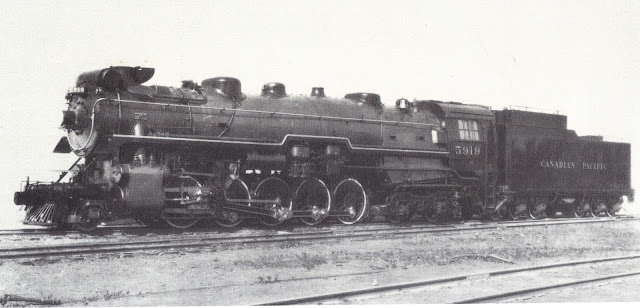The CPR Selkirk class was built to haul freight and passenger trains through the challenging terrain between Calgary and Revelstoke. Though across the border in the US much larger locomotives were in common use, they were the largest locomotives built in the British Empire. Twenty were built in 1929, a further ten in 1938, and six in 1949. They worked till the dieselization of the CPR in 1959.
Wednesday, November 30, 2016
Monday, November 28, 2016
Sunday, November 27, 2016
Facel Vega Mk2 1962-64
The Facel Vega Mk2 was the last attempt of the Facel Company to produce a luxury touring car. The car was billed as the "World's fastest 4 seater". The 383 Chrysler engine gave the vehicle more than enough power for a top speed of 150 mph. One hundred eighty were produced before the company closed their doors.
In 1960 the company had introduced a smaller similiarly styled sports car named the Facellia (below). The company had developed their own 1600cc engine for this car. Unfortunately the engine had camshaft problems and suffered enough warranty claims to cause the company's bankrupcy in 1964.
Eleven hundred were produced.
Fleet Fort Trainer
View showing the unusual wing bracing.
Saturday, November 26, 2016
Kawasaki W1 1966
The first "Big Bike from Japan", when the company was still Kawasaki Aircraft Co. This four page ad at the front of the magazine showed their commitment to this project but the 1969 H1 triple was far more successful.
Friday, November 25, 2016
The Short Mayo Composite
 |
| Henry R Palmer, The Seaplanes, Leonard Morgan Publishing, 1965 |
Seemed like a good idea at the time...
The 1937 Short Mayo Composite was an experiment in long distance seaplane flight. The smaller Mercury seaplane, loaded with a 1000lb payload and enough fuel for a trans-ocean trip could not lift off the water and this was the ungainly solution. The launch was a success- the Mercury flew from England to Montreal in 1938 and was the first commercial Atlantic crossing by a heavier-than-air craft. In 1939, the Mercury was launched in the same way and flew non-stop 5998 miles from Dundee, Ireland to South Africa for a new long distance seaplane record. Needless to say, this method of launch was too expensive, tricky and dangerous and was soon abandoned.
The war put paid to the project. Maia was destroyed at harbour by German bombs in May 1941. The same year, Mercury was broken up for the value of her aluminum for the war effort. While the idea of a composite aircraft may have been destined to become just a footnote in aviation history, the idea was revived in 1976 as the inspiration for ferrying the space shuttle on a Boeing 747.
Mystery tailstock and steady rest
From the "I picked these lathe parts up years ago for reasons long forgotten" department and I have no idea what make they are. They appear to be from a 10" swing lathe, the ways are 3.5" wide centre to centre and there are no identifying marks anywhere. The ways are not South Bend, either for my 9" or the ancient 11". They don't appear to be Atlas either. Anyone have any ideas?

Thursday, November 24, 2016
HMCS Barrie
Wednesday, November 23, 2016
Tuesday, November 22, 2016
Cunard in NYC, 1954
Mail Service Lancaster
 |
| Larry Milberry, Aviation in Canada, McGraw-Hill Ryerson 1979 |
Monday, November 21, 2016
Port Huron Engine and Thresher Co. 1915
Suzuki K11 1965
They don't often look like that when you find them now.
This is a 1967 model with Posi-force oil injection.
Sunday, November 20, 2016
Steam yacht, Buzz
 |
| D.W. Fostle, Speedboat, Mystic Seaport Museum, 1988 |
Buzz was 50' long with a 6'6" beam and drew only 16" of water. She was clocked at nearly 27 mph, and may have been the fastest boat in America at the time.
The two cylinder steam engine was also designed by Mosher, steam was provided by a boiler from a steam locomotive.
Saturday, November 19, 2016
Friday, November 18, 2016
Wasaga Beach to Baghdad
 |
| Larry Milberry, Aviation in Canada, McGraw-Hill Ryerson 1979 |
Thursday, November 17, 2016
Wednesday, November 16, 2016
Walter's dilemna
When you acquire a motorcycle that looks like the one above, you can paint it any colour you want. So what colour is it going to be,Walter?
Black?
White?
Red? Or leave it like it is and go racing!
Seen at the Barber Vintage Festival
Tuesday, November 15, 2016
Armstrong- Siddeley Special
Monday, November 14, 2016
General Electric electric welders, 1921
Automatic welding was invented by P.O. Nobel of the General Electric Company and introduced in 1920. It utilized bare electrode wire operated on direct current and utilized arc voltage as the basis of regulating the feed rate. Railway and machine shops used it to build up worn motor shafts and worn crane wheels.
Saturday, November 12, 2016
Subscribe to:
Comments (Atom)












































